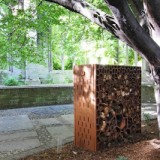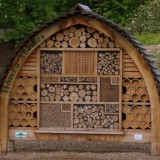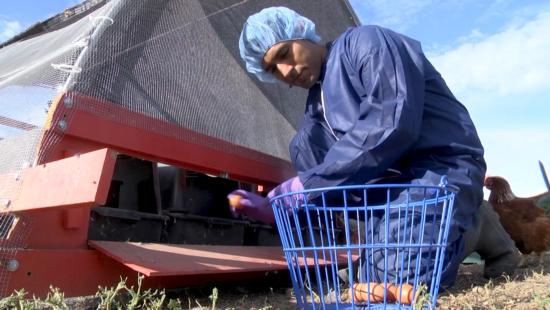With a growing awareness of the plight of honeybees more people are calling on the services of beekeepers rather than exterminators. And, thanks to a crash course in bee removal and relocation from Backwards Beekeeping guru Kirk Anderson, I’ve managed to help relocate about ten or so hives, giving them new homes with Los Angeles’ hobby beekeepers. Each removal has been different and I’ve made plenty of mistakes. But with each experience I’ve learned valuable lessons. Last week I started my first solo “trap-out.”
In a trap-out you make a one way exit for bees that are somewhere they aren’t wanted, in this case a kitchen vent. Foraging bees leave the hive but can’t come back in. Next to the one way exit you place a “nuc” box (a cardboard box that holds five frames) that contains open brood comb, cells with eggs and larvae, from another hive. The workers can’t get back into their old home, adopt the brood comb in the box and use it to create a new queen. The process takes at least four to six weeks since you have to wait for the old queen to stop laying eggs and for all the bees in the wall to make their way out. At then end of the six weeks the beekeeper takes away the nuc box, now hopefully full of bees with a new queen. After I remove the nuc box I’m going to open up the vent and clean out any remaining comb and honey. I’ve heard of opening back up the old hive and letting the bees clean out the honey, but I’d be worried they would move back in. And what happens to the old queen is a mystery to me. Different sources give conflicting information. She either flies off, dies or fights her way into the new colony.
The alternative to a trap-out is to do a “cut-out” opening up the wall and physically removing the bees and their comb. Cut-outs are traumatic for the bees and make an incredible mess of the house. The advantage is that the removal is over in one day at the most. In this case I decided to do a trap-out so that I could save the homeowner, on a fixed income, from the expense of having to replace the kitchen vent the bees are living in.
Her house, cantilevered over a steep hillside in the Hollywood Hills presented a few challenges. I had to work from above, leaning over the edge of the roof to attach the escape cone to the vent. One thing I’ve learned is to have everything fabricated and all tools ready before beginning any structural bee removal. You need to act carefully and decisively when you’ve got thousands of pissed off bees flying around. I made the cone out of 1/8 inch hardware cloth attached to a rectangular piece of the same material to block off the entire vent. I smoked the bees to calm them down. Next, I leaned over the edge of the roof and quickly hammered the cone in place with roofing nails. It would have been better to attach the cone early in the morning before the bees had left for the day, but logistically this was impossible for me. As soon as nailed the escape in place a large cloud of returning workers started bearding at their former entrance at the base of the cone. Another angry contingent pinged the front of my veil. Using rope, I lowered the nuc box with the open brood in it and secured it to a concrete block I placed on the roof. When I came back the next day the bees had calmed down and were starting to come and go from the nuc box. Some were still “bearding” at their old entrance.
There are two kinds of one way exits. You can make one by creating a cone, at least a foot long out of 1/8 inch hardware cloth with a 3/8 inch opening at the end. This is enough, usually, to throw off the bee’s precise orientation to their old entrance. They leave but can’t come back in. Alternately, you can use a Porter bee escape, a spring loaded device that lets bees out but prevents their re-entry. Each method has its advantages and disadvantages. Sometimes the bees figure out how to get back through the cone. In that case you can put another cone around the existing cone. The bees entering the second cone end up back outside. The disadvantage with the Porter bee escape is that its small springs can sometimes fail under the strain of thousands of workers passing through. My neighbor Ray, a beekeeper and airline mechanic, examined the two bee escapes sold by our local supplier. Not surprisingly, the English made escape was superior to a Chinese made model which had a poor connection between the springs and plastic body.
There’s a lot that can go wrong. In a trap-out that I’m helping Ray with underneath a poorly constructed concrete patio, the bees keep finding new ways to chew their way out. This could be interesting if we were dealing with a wall and the bees were to find their way into the house. With the patio it’s simply frustrating. The bees gave up on the brood and now we need to find more and wait another six weeks for the process to end. With my kitchen vent bees I blocked off the grill above the stove with metal screen and aluminum foil. Next time I’ll use sheet metal. The bees have chewed their way underneath the aluminum foil. The screen keeps them out of the house, but the foil is amplifying their buzzing. I’ve created an unintentional acoustic bee amplifier which is disconcerting to the homeowner! I also had to come back and rig up a sheet metal tray underneath the vent to catch the bits of comb, mites and dirt that the bees shed. While my trap-out seems to be working, I still have to keep my fingers crossed that the bees make a new queen and that she mates without getting eaten by a bird or squashed on a windshield. And Kirk is right, the process is more about managing the people than the bees. You have to have a homeowner who is willing to stick with a six week process and tolerate a box of bees strapped to the side of their house.
Still, I really enjoy the process. It combines a few of my favorite things, nature, heights, low-tech gadgets and diplomacy. I wish I could do this more often but we don’t have room in our yard for bees.
For more information on the trap-out process see, Charles Martin Simons’ article “Fundamentals and Finesse of Structural Bee Removal.”
If you’re in LA and have bees you need relocated call the Backwards Beekeepers rescue hotline at (213) 373-1104.
And lastly, while I love bees I would not want them in my house. Prevent what could be an expensive problem by making sure that small cracks on the outside of your house are sealed off.










Eric
great job of relocating the hives… we had some bees begin to start a hive in the attic through a soffit vent and I tried, successfully at first and then ultimately unsuccessfully to ‘smoke’ them out of the attic using incense (the only combustible I could rustle up) It irritated them enough for them to stop using the attic, but a week after I stopped they moved back in and we took the unfortunate step of having them ‘ euthanized’ which we were quite sad about… the location at the corner of the attic made it difficult for the guy to remove them safely.
Keep up the good work
Gary
Pingback: How to Remove Bees From a Tree | Root Simple
Pingback: How to Remove Bees From a Tree | Content Curated By Darin R. McClure & a few photos